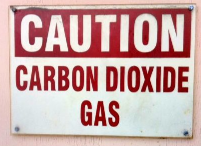
Those of us who live and breathe climate and energy issues know the answer to typical pop quiz questions like, "What's the nation most responsible for climate change?" Well, the largest emitter of carbon into the atmosphere is currently China, but historically the United States is responsible for the lion's share, with nearly 30% of the total emitted since the mid-1800s.
But if the question is "which corporate entity wins the dubious distinction of being the largest contributor of carbon emissions to the atmosphere?" we might struggle more. Peabody Coal? No, more probably ExxonMobil. But what about Royal Dutch Shell, which has the highest current revenue? And then there's BP, no longer bothering trying to rebrand itself as Beyond Petroleum. The actual winner? (Drum roll, please.)

Carbon Visuals developed to augment the Carbon Majors report.
Chevron. Yes, "The Power of Human Energy," San Francisco Bay Area-based Chevron, along with its various corporate acquisitions, including, over the years, Unocal, Texaco, Gulf, and Getty.
In a new paper ripe for educational teachable moments, "Tracing anthropogenic carbon dioxide and methane emissions to fossil fuel and cement producers 1854-2010," published in the esteemed journal Climatic Change—author Richard Heede identifies the 90 "carbon majors." We're talking 56 oil and gas companies, 37 coal producers, and 7 cement producers that produced most (63%) of the total emissions vented into the atmosphere between 1751 and 2010.
While not easily sliced and diced for educational uses, the report nevertheless is a treasure trove of data and details that can and should be unpacked in science education classrooms. The mathematics, conversions, history, and scientific due diligence that can be parsed from the report will help us all better understand the role of buried solar energy, aka fossil fuels, in our lives.
Perhaps the two biggest corporate majors, Chevron and ExxonMobil, would agree that the study provides a real-world context for tackling global problems with science and mathematics, since they are both supporters of the Next Generation Science Standards, which include a focus on human impacts on the environment in general and a focus on climate change at the middle and high school level.
ExxonMobil, after all, emphasized how important math and science education is in the United States through its support of the National Math and Science Initiative, donating $125 million to help the cause.
Not to be outdone, Chevron contributed $1.5 million to a new K-12 Engineering Education Initiative with the National Academy of Engineering. Blair Blackwell, manager of education and corporate programs at Chevron, noted the company's involvement with many STEM (Science, Technology, Engineering, Mathematics) initiatives including Project Lead the Way and the California STEM Learning Network.
Chevron and Exxon Mobil may be the largest investor-owned companies in terms of cumulative emissions, with respectively 51.1 and 46.67 gigatons of total carbon dixoide equivalent emissions, but two nation-state entities—the former Soviet Union with its combined oil, gas, and coal, and China with its coal and cement production—are significantly larger, at 129.72 and 124.09 gigatons of carbon dioxide, putting them in the first and second place for overall emissions.
Rounding out the top ten of cumulative producers: Saudi Aramco, BP, Gazprom, Royal Dutch Shell, National Iranian Oil Company, and the nation of Poland, the host of the recent 19th Conference of the Parties for the United Nations Framework Convention on Climate Change, but still an unabashed fan of coal.
